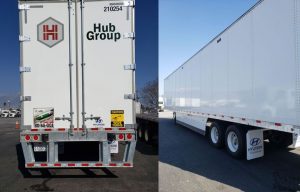Hub building higher trailers
Trailers are 13 feet, 6 inches high, right? That’s not always the case for Oakbrook, Ill.-based Hub Group, which developed a special 14-foot-high trailer designed for a dedicated customer based in California.

Hub building higher trailers
Many western states allow 14-foot-high trailers – a couple even 14-foot-6-inches, said Gerry Mead, executive vice president of maintenance and equipment for Hub Group and a former HDT Truck Fleet Innovator. “Of course, they operate on designated highways, and you still have to be aware of your bridges.’’
Even though 14-foot trailers aren’t exactly new, Mead said, for this specific customer’s needs there wasn’t anything off-the-shelf that would work. So he and his team worked on developing a specification that would allow the greater amount of freight without being too heavy for the floor or making the combination overweight – while dealing with the driving dynamics of six more inches of trailer height.
Hub building higher trailers. Hub Group, which developed a special 14-foot-high trailer designed for a dedicated customer based in California.
“If you make that wall taller, it changes the dynamics of roof bow placements,” Mead said. “And we were going to haul heavier weights, so we had to pay attention to the cross members and the floor. We had to be very careful in how we designed it. We came up with a strong, capable trailer that can haul a lot more weight. These weren’t something you’re going to go rent.’’
Enjoying our insights?
Subscribe to our newsletter to keep up with the latest industry trends and developments.
Stay Informed
Mead worked with suppliers such as Hyundai trailers, Havco floors, ConMet, Phillips Industries, and Truck-Lite.
To develop a trailer that was lightweight and strong, Mead said, his company moved the cross members closer together but used a lighter-weight composite floor.
“We brought the roof bows in closer to give more strength to the roof area, and that gives you more connection points on the sidewall,’’ Mead said.
Because trailers normally sway side to side a bit going down the road, Mead’s trailer was designed to reduce swaying caused by added height.
He likened the design to that of a suspension bridge, where the strength results from the design of the system as a whole.
Mead recently returned from a visit to the California facilities to see how the 20 trailers are doing after six months on the road.
“They look good,” he said. “I’ll be excited to see where they are in a few years.”




















